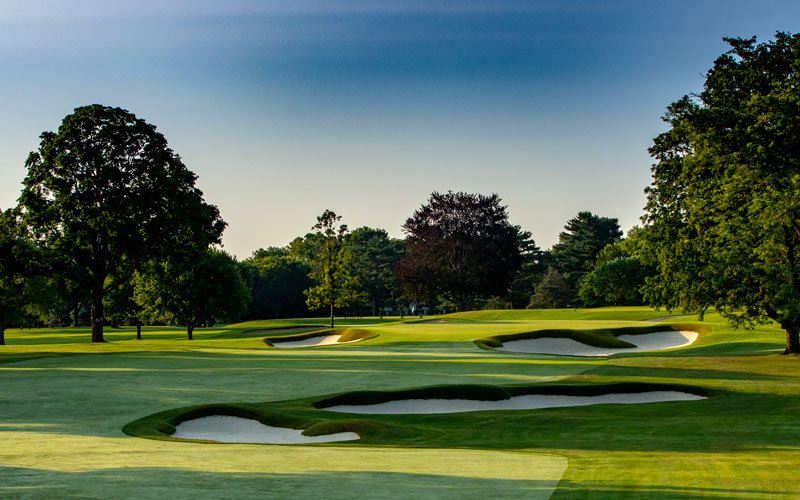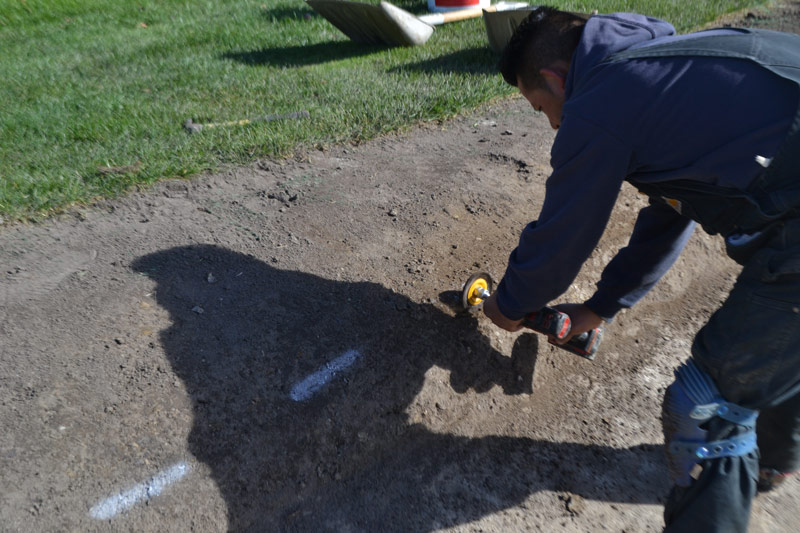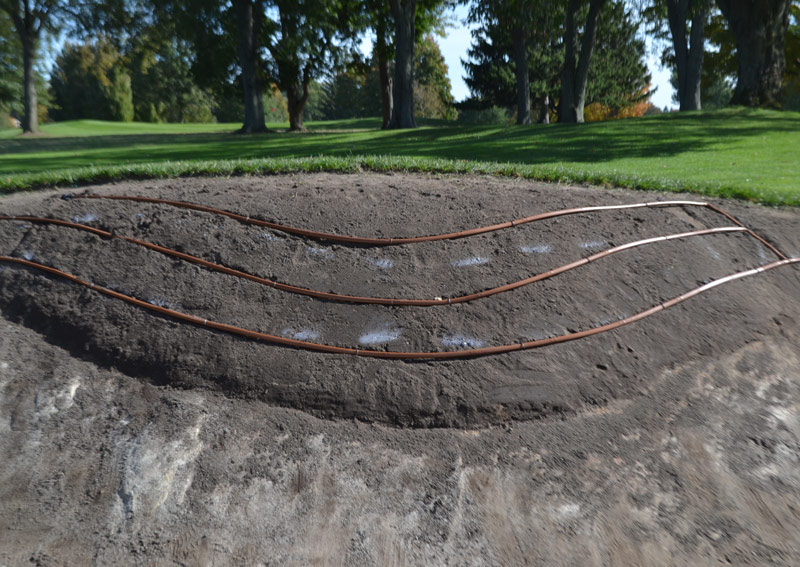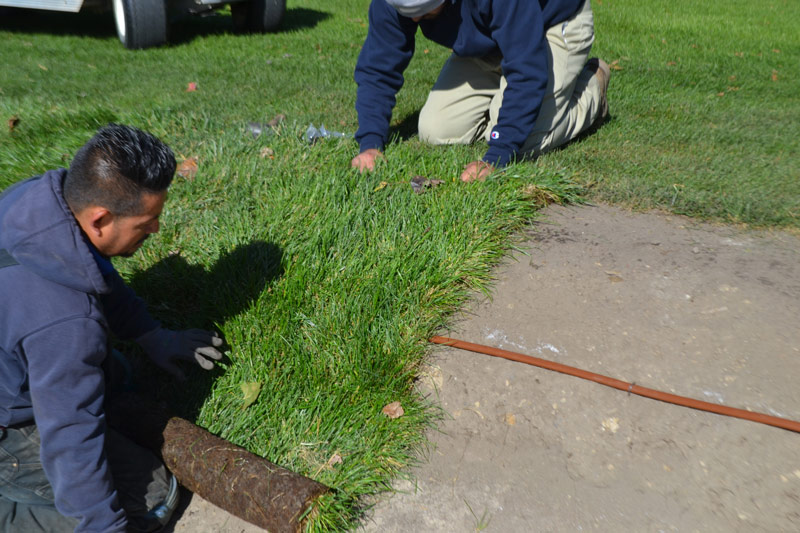
Country Club of Detroit superintendent Ross Miller and his team have ensured bunker surrounds look their best while also dramatically reducing the amount of water needed to maintain them. Shown here is the 18th hole. Photos courtesy of Ross Miller
Editor’s note: A version of this article first appeared in Course Conditions, a quarterly publication of the Michigan GCSA.
Bunker maintenance is always a topic of discussion at any golf venue, as every site differs in maintenance strategies, end-product goals, sunlight angles on the turf around each bunker, etc.
One of our goals here at the Country Club of Detroit in Grosse Pointe Farms, Mich., is to make all of our bunkers look homogenous. We have 69 bunkers on the 18-hole course, for a total footprint of 98,000 square feet. All bunkers are similarly shaped; all have “eyebrows” and steep, flashed faces; and all are surrounded by dense monostands of turf.
The golf course was built in the 1920s, without the use of extensive earthmoving equipment, and it is relatively flat. The bunkers and their eyebrows lend not only the obvious hazard influence, but also a strong aesthetic influence to the parkland course, as they flow well with the topography and are part of the original C. H. Alison design. In 2010, CC of Detroit made a substantial investment to renovate its bunkers as part of a larger-scale renovation of the property with Renaissance Golf Design.
In 2014, the club made the switch to all city water as our irrigation source, replacing the raw lake water we had used previously. This change caused an enormous increase in operating budget dollars being invested in water — from around $8,000 annually to north of $200,000 — as the cost became not only the water, but also the treatment of drainage water leaving the property, as sewers are not separated here in Grosse Pointe Farms. With this, a challenge arose not only to figure out the operating delta, but to take vigilant water management to another level.
How do the bunkers figure into all of this, you may be asking? Well, let’s dig into our case study!
The bunkers at the Country Club of Detroit all had landscape spray heads installed around them, on 12- to 15-foot centers, to help provide supplemental irrigation to the rolled-edge-sod bunkers. While still providing good supplemental water to these faces, we wanted to look into ways to be as precise as possible with our water applications. We also wanted to explore turfgrasses that would be able to withstand substantial sand splash from play.
Four years after the renovation of the bunkers, there had been a significant amount of stress to and loss of the Kentucky bluegrass surrounds of many of the bunkers, especially those on south-facing slopes and in areas with heavy sand splash. The spray zones around each bunker were providing supplemental water, but at a rather large volume. The average amount of water used in each spray zone around each bunker on the property was about 31 gallons per minute. At four four-minute cycles three times per week, this volume of water added up very quickly.
With the goal of water reduction at the forefront plus the possibility of regrassing bunker surrounds, we began to investigate the options that drip irrigation presented for us. The hope was that such site-specific, targeted irrigation would minimize wasted water and unnecessary runoff.
We renovated four bunkers with drip irrigation tubing running parallel with the slope of the faces, with emitters on 12-inch centers. If there were large slopes, we integrated extra tubing on 12-inch centers parallel with the face. No drip irrigation was integrated on the bottom, walk-in parts of the bunkers. One of our foremen, Martin Perez, came up with an idea to use a cordless drill with a wire wheel to create a small channel for the drip irrigation tubing prior to sodding these bunker faces. We were fortunate to have the help of Derek Carroll and FIP Irrigation Services for this initial trial install.

Country Club of Detroit foreman Martin Perez wire-wheels a 1-inch-deep trench where a drip line will be installed.

An arrangement of drip lines on 12-inch centers on a bunker eyebrow before sodding.

Installation of turf-type tall fescue on a bunker surround.
The bunkers on which we established drip irrigation were all on south-facing slopes and had experienced a great deal of turf loss in previous years from heat stress and sand splash. Following the drip irrigation installation, we regrassed these bunkers with turf-type tall fescue sod — a mix of NoNet and Summer — to further curb stress from heat and sand splash.
After a successful first year with these four bunkers, we decided to implement a full-scale bunker renovation plan for the entire property, to be undertaken in-house and completed in four years.
Now, more than six years later, the bunkers that were completed in 2014 are still going strong, and the rest of the bunkers that were outfitted with drip irrigation after the test run have also been a success, with zero issues related to turf health or the drip irrigation setup. And the water reduction has been phenomenal: an average of 31 gallons per minute slashed to 3 gallons per hour, or a 99.8% reduction in water use around bunkers.
How do we maintain control of each of these new drip irrigation zones around bunkers? We repurposed the electric valves from the landscape spray zones, adding a scrubber valve and new pressure regulators. We also added filter screens to mitigate any issues with water quality that may arise down the road, should we ever switch back to a raw water source. These filter screens are pulled each spring, cleaned and then put back in their respective locations as a preventive maintenance measure.
Editor’s note: Bunker edges can be an agronomic Achilles’ heel. Check out a Canadian superintendent’s inside-out approach for improved aesthetics in Bunker edges: Inverted-sod technique.
Some of the drip irrigation zones are unfortunately not tied in with the central control of the rest of the irrigation program, so these are individually programmed with a Rain Bird TBOS controller — a very cost-effective solution in the interim that allows us to write our own programs and upload them to each station individually in minutes.
These changes have allowed the bunkering to remain a vital part of the puzzle here at CC of Detroit while not becoming a liability from a maintenance, irrigation, financial or aesthetic standpoint.
Ross Miller is the GCSAA Class A superintendent at the Country Club of Detroit in Grosse Pointe Farms, Mich., where he has worked for eight years. A Penn State graduate, Miller serves on the Michigan GCSA’s board of directors and is an 18-year GCSAA member.